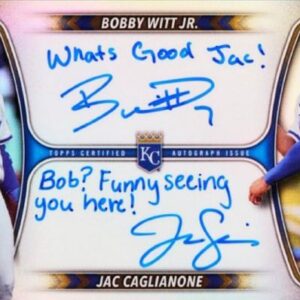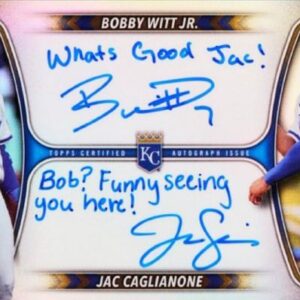In the labyrinthine hustle and bustle of New York City’s subway system, most commuters are propelled by a singular goal—to get from Point A to Point B with minimal delays and a semblance of personal space intact. Yet for Phil Imbriano, a senior designer at beloved trading card company Topps, this quotidian voyage sparked a creative epiphany that would shape the 2025 series of the cherished baseball card set. A glimmer here, a sleek line there, and suddenly, the familiar metal tubes and routine blur of stations transcended mere functionality to light the fuse of artistic creation.
Imbriano, whose design chops have helped maintain Topps’ preeminence in the collectible card world, was struck by the elegance found not in museum halls or art galleries, but on the metallic corner of an ordinary NYC train car. “I love drawing inspiration from everyday things,” he muses, highlighting the power and unpredictability of artistic muses often disguised within the mundane.
The serendipitous sighting—a combination of striking red and silver curves that stood in sharp relief against its industrial setting—became the catalyst he needed. By the time the subway doors swooshed open at his station, he had captured the moment with a quick snapshot. Fast forward through the morning chaos, and Imbriano was perched at his desk, sketching the seed of what would become the foundational design for the 2025 Topps Series 1 baseball cards, debuting to eager collectors today.
In this new design, two bold lines arch gracefully across the card, starting boldly from the left and sweeping up to the right, mirroring the lines that had captivated him during that formative commute. “That marriage of form and line, that’s what struck me,” Imbriano explains. To some aficionados of the craft, the design may awaken memories of the 1982 Topps set, with its now-iconic visual markers. However, this spontaneous nod to history was entirely unintentional. The true kernel of inspiration came from the woodgrain textures of the 1962 and 1987 sets, which Imbriano initially sought to emulate with a contemporary twist. “The ’82 connection was a happy accident,” he admits, though a fortuitous one, deftly weaving vintage threads into the hot, beating heart of the modern design era.
The path from concept to final product is as layered as a well-played baseball game, involving a competitive in-house process that pits creative minds against one another in friendly rivalry. Imbriano’s concept emerged victorious against 20 other robust contenders, passing through a gauntlet of feedback and refining stages until it became the polished gem seen today. “I don’t think most people realize how much work happens before they ever hold the card in their hands,” he reflects, perhaps tempting us all to consider the invisible web of effort behind every mundane artifact.
Designing cards is akin to crafting a visual symphony where each element must stand independently yet harmoniously amongst its peers—much like the balance of instruments in an orchestra. Imbriano likens this to crafting movie posters, envisioning each card as a mini poster that encapsulates its era. The final series is one that collectors can easily identify in the future, binding them to the year it was created with nostalgia and boldness.
Beyond just a single collection of players, the Topps Series 1 includes popular subsets that delight fans and collectors alike. They tap into the depths of baseball culture and history, from the “Future Stars” to “City Connect Swatch Collection Autographs,” providing layers of interest and forms of engagement fit for the modern aficionado.
Even the celebrities who have graced baseball with ceremonial first pitches find their moment to shine in the subset “First Pitch”. Topps cleverly taps into icons both sporty and cultural, pairing players with chart-topping artists to reveal a new “Signature Tunes” offering—where music meets baseball in a novel partnership.
For Los Angeles Dodgers fans, there’s a whimsical bonus—this year’s collection is accompanied by special base-card versions commemorating Freddie Freeman’s infamous hip sway, a boisterous celebration of spirit and camaraderie that goes past mere statistics or line scores.
Highlighting echoes of its storied past, the 35th-anniversary tribute revisits the colorful vibe of 1990, a year embedded in memory with its adventuresome palette that dared to be bold. Yet the heart of the matter is the narrative richness in every card, a story within each frame, standing boldly amid the personal and shared histories of baseball fandom.
Design philosophy at Topps remains vibrant and future-focused—a conviction that through the synergy of talent, inspiration, and technology, each new series offers more than an echo of the one before. As collectors grasp their packets and feel the crinkle of opening, they participate in the shared heritage of collecting and the visceral joy of fresh discovery.
Fifty years from now, a collector—anonymous and intrigued—might leaf through an album and stop at 2025. They’ll trace the elegant lines of Imbriano’s cards with a smile, feel the nostalgia, and recognize the creative genius wrought from a moment on a mundane train journey. Perhaps, even briefly, they’ll ponder the serendipity that led a designer’s eye to that glint of possibility, back in the industrial hum of a subway ride.





